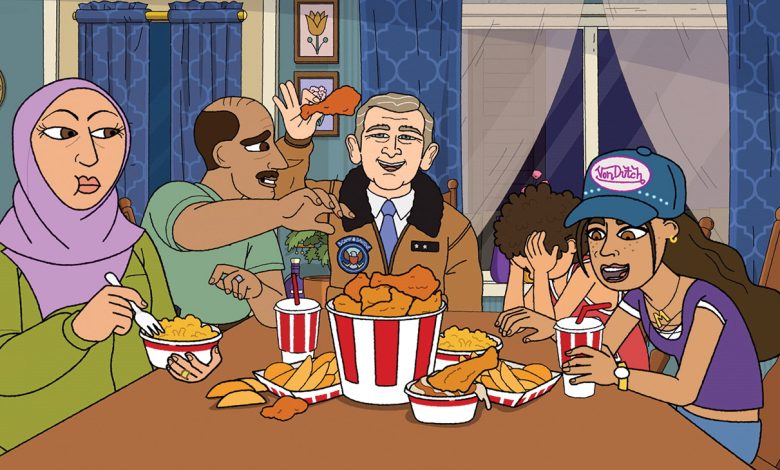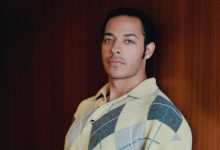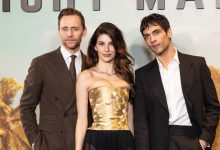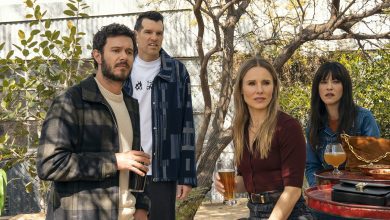Ramy Youssef Talks Using Hand-Drawn Animation to Find Humor in Dark Reality of ‘#1 Happy Family USA’

When you’re 12 years old, everything that happens is a “matter of international security,” according to Ramy Youssef. His animated series #1 Happy Family USA literalizes that for its hero, Rumi, a tween Egyptian boy growing up in post-9/11 New Jersey. As a Muslim American dealing with widespread xenophobia, Rumi has to worry about more than just whether his crush likes him.
” ‘I didn’t get invited to Courtney’s pool party’ is 9/11 when you’re a kid,” Youssef says. “This is where I really draw from my own real childhood, where you go, ‘What did Courtney say behind my back?’ But then, ‘And are the phones in our house being tapped?’ ”

The fact that the sitcom, which Youssef co-created with Pam Brady, is animated gives the comedian free rein to take his often serious premise to ludicrous levels. Rumi, voiced by Youssef, encounters a talking lamb. His dad, Hussein (also Youssef), breaks out into song. And George W. Bush stops by for dinner. Youssef spoke to THR about figuring out the show’s tricky tone and the inspiration behind the character design.
When did animation come into your thought process in terms of telling this story?
I was really into this idea of code-switching in this way that you could actually see. There were probably two ideas that made me think, “OK, this is an animated show.” One was that the characters would literally look different when they were inside and when they were outside, and it would happen in the doorway. That was just an observation of how you have a different feeling in your body the second you step out of the door, and I think that everyone feels that way. And then it felt like it would be even more amplified by this family ending up in the crosshairs of a disaster. The other piece was thinking about, what can you do with characters in this format that you couldn’t do in live-action? I would think about my grandmother, who’s always watching TV, and then say, “OK, well, what if this character just always has her TV with her and she’s never anywhere without her TV?” It’s the most important thing to her. That starts to create this world that we got to build.
How did you discuss character design with illustrator and executive producer Mona Chalabi?
We talked a lot about eyes and what’s happening with their pupils: When are they veiny, and which way are they looking, and how are they moving? So much of the animation style was wanting it to feel like this found VHS. Almost that, hey, this show could have come out in 2001. The hand-drawn-ness is not an aesthetic, that’s how we made it. Everything was informed by what was going to put the audience in this family’s shoes because it’s a period of time that has really only been looked at in terms of English-speaking pop culture — art has really only been examined in one way, and now we get to look at it a different way.
How did you think about discussing 9/11 but mixing it with absurdist humor?
Everything is at the expense of someone’s psychosis. It tends to be looking at: How do you make fun of, not what happened but how it affected the people who were there? I’m always interested in characters who are committing these self-inflicted wounds. That is my favorite way to watch a character flail around. These characters certainly have this larger wound that is being inflicted around them and on them, and then they’re still doing it to themselves while that’s happening, too. There are very sincere things that are said on this show that are totally undercut, whether they be really emotional moments that are immediately undercut by the right fart or whatever it is. That cacophony of that is really fun because that’s all comedy is. I don’t find this show to have any desecration of anything that’s holy to anybody. It is all about how everyone treated each other and treated themselves after it. That’s what’s up for grabs.
Rumi wears a bootleg Bulls jersey the whole show that reads “Balls.” Where did that come from?
The joke was based on a real life thing that happened to me, which was I asked my parents for a Michael Jordan jersey and they got me one that basically fit me like a dress because it was so expensive that they were like, “You’re going to grow into it.” I remember going to school and partly I was like, “Wait, are people going to think this is cool or are they going to think it’s a dress?” That was the joke. Then we got to this place where we realized that apparently Michael Jordan is incredibly litigious, do not put Bulls on this kid’s thing. And that’s where one of our producers, Andy Campagna was like, she pitched, “What if it’s just ‘Balls’?” I was like, “I think that’s actually so much better.” It felt in a way even more of an immigrant move to just get the total bootleg. What was a money saving move for the show, not wanting to be sued became a money saving move for the Husseins.
Why did you want to voice both Rumi and his father Hussein?
I didn’t want to, it just happened. It was not something I’d done a lot of, but Pam really pushed me. She was like, “I really think you’d have a good take on Hussein.” And I was like, “I don’t know. Let me mess around with it.” Then I really did find something that, if I think about this piece, the thing that pops out to me the most is the character of Hussein and just artistically getting to voice him and write songs in his voice. He’s almost the personification of anxiety and this frenetic live wire, a character I have not played at a 10 like that in live action that I don’t even know you could play at a 10 like that in live action. It would just be too insane. On his flip side, he’s super tender and he writes this music that’s almost like folk. Someone was like, “Dude, this sounds like The War on Drugs, or Leonard Cohen.” Someone called it Kebab Dylan. He has this side to him that I do think men have. It’s fun to bring that level of insanity and at the same time nuance to something in an animation.
George W. Bush shows up as a character on the show. Why did you want to incorporate a real life figure?
Part of our calculation was just making sure that we weren’t doing some sort of loving revisionist history or anything, because I think there’s a conversation of, “Oh, man, don’t you miss George Bush?” And I don’t. I wanted to make sure that we were seeing him through the lens of a kid. He kind of becomes just the peak of how adults can kind of pull one over on kids. The stakes here become higher because it’s not, “Hey, Rumi, this is your bedtime.” It’s, “Hey, you’re going to help me fight the War on Terror.” That felt like a really cool way to show that this guy, he’s got this big smile on, but he is not a good dude. We talked about a lot of ways of how to approach him, and I felt like we found a portrayal that’s not the one that had been floating around, because George Bush is one of the most made fun of presidents ever. But I think that what we end up getting to do in the show certainly goes at it from a different lens.
Source: Hollywoodreporter
HiCelebNews online magazine publishes interesting content every day in the TV section of the entertainment category. Follow us to read the latest news.
Related Posts
- TV Ratings: NBA Finals Fall, Tony Awards Surge
- 'A Tree Fell in the Woods'
Jeff Leeds-Cohn
Share on Facebook
…
- Glen Powell's Ex Gigi Paris Breaks Her Silence on Sydney Sweeney Romance Rumors After Their Public Split: 'I Hope They're in Love'
- Secretly Group Acquires 50 Percent Stake in Merge Records
- Brooke Shields' Podcast Interview Criticizing Meghan Markle Quietly Deleted





